Welcome
-
Recent Posts
Recent Comments
- Souvik patra on রুবিকস কিউব (পর্ব ৪) : রুবিকস কিউবের সমাধান
- Al amin on গণিত অলিম্পিয়াডের প্রস্তুতি: কিছু সাধারণ প্রশ্নের জবাব (FAQ): পর্ব ১
- Rakin sadab on গণিত অলিম্পিয়াডের প্রস্তুতি: কিছু সাধারণ প্রশ্নের জবাব (FAQ): পর্ব ১
- MD. Rakin sadab on ফিজিক্স অলিম্পিয়াডের প্রস্তুতি নিয়ে কিছু কথা: ইমরোজ খান (BUET, EEE)
- Riyan on ফিজিক্স অলিম্পিয়াডের প্রস্তুতি নিয়ে কিছু কথা: ইমরোজ খান (BUET, EEE)
Archives
Categories
-
Links
Tag Archives: tutorial
Play with Python (Part 2): Preparing for the Magic
(After the previous part: Part 1: The Magic Behind Computers)
Summary: Install python, learn how to start coding, and plan to successfully finish the tutorial!
How to install Python:
I have lectured enough about the reasons for learning programming and the theories behind computers, but I know that you are not here for those! You want to learn how to make that game, right? But before you do so, you need to install python in your computer. First, you need python installer (skip if you are using ubuntu or linux). Get the python installer from this link: http://www.python.org/getit/
You can see a lot of installers here. Don’t get confused! For this tutorial we will use 32-bit python 2.7 (at the time of the writeup the latest version is 2.7.6). So download the correct installer file to your computer (see the image above).
Windows:
As usual double click on the installer and let it get installed (click ‘next’ and ‘ok’ many times!).
OS X:
Double click on the package manager and install the package.
Ubuntu/Linux:
If you are using Ubuntu you’re all set, because Ubuntu comes with python pre-installed!
Basics and Sanity Check:
So when you write code, Python has an engine (interpreter) that turns your code into instructions that computers can read (those are basically collections of 0’s and 1’s and only computers can understand them). To give commands to computers python has a program (interface) called IDLE. Now to check if the installation worked properly, open IDLE from your programs.
(Windows: Start Menu>All Programs > Python2.7>IDLE (Python GUI), in general you should get it in the list of programs in any operating system).
Now you should see the following window (minus the code text):
Now the “>>>” is the terminal where you can enter any valid python command and it will show you the output. Now type:
print "Hello world! I am learning to code!"
And you should see the output text. Congratulations! You have written your first piece of code!
So what you just did is that you outputted some text on the screen and print is the command for doing so in python. We will explain all these in a lot more details in the next chapters, but for now enjoy your new super power of being able to code!
Now try to do these math with python (We have also included the output. Of course you don’t need to type those!):
|
1 2 3 4 5 6 7 8 9 10 11 12 |
>>> 2 + 3 5 >>> 5 - 1 4 >>> 2 * 3 6 >>> 4 / 2 2 >>> 3 % 2 1 >>> 2 ** 3 8 |
First thing you noticed is that I have added white space in between everything. You don’t really need to do this, but this makes your code look a lot cleaner. So before and after arithmetic signs we add these spaces. Finally, what let’s figure out what these signs are doing. The first one + = addition, - = subtraction, * = multiplication, / = division. Let’s stop for a second– “but what are the next two?” you may ask. and you probably have not seen these before. Don’t worry, they are easy to understand!
The first one is “%” is modulo sign. In python a % b means you are asking for the remainder of a upon division by b. For example: 3 % 2 gave us 1 because that’s the remainder you get when you divide 3 by 2. This is a great way to check if a number is odd or even! If the remainder is 1 the number is odd, and even if it is 0!
The next one, ** means to the power. So a ** b means ab in math. And that means you are multiplying b number of a’s together. More explicitly: 2 ** 3 means 23 = 2 x 2 x 2 (i.e. multiplying 3, 2s).
Play with both the modulo and power operations on the terminal before these concepts make more sense!
Starting to Code:
Now you’re probably thinking, if you enter one line at a time and do simple addition and subtraction then probably you cannot do much. You are absolutely right! That’s why programmers write their programs in a simple text file and then make the language compiler software to run it. As we are becoming pros, we will do the same!
Select File > New Window (or press control + N). You should see a blank screen. This is just a fancy text editor (like notepad), but as you type you will see that the text contents are getting nice color coding (the color coding has a fancy name– syntax highlighting)! Now type:
|
1 2 3 4 5 |
# Printing print "Hello world! I am learning to code!" # Arithmetic operations print 2 + 3, 3 - 2, 2 * 3, 4 / 2, 3 % 2 |
Finally select: Run > Run Module or press F5 key on keyboard and it will probably ask you to save the file. Now give the file any name and end the name with .py (we named it first.py). It is the python file extension (like .pdf, .exe etc) and if you do this the computer will understand that it is python code! Now you can see the output printed in the terminal. Neat!
By the way, the gray texts after the hashtags (#) are called comments. When python runs the code, it goes from top to bottom, but ignores the comments. The goal of these comments is to make the code more clear to the human readers, but you can choose not to type them.
How to a complete this tutorial successfully:
Remember the last time you sat down to learn something? Yes, I do too! And I did not finish it! So it is important that you follow these instructions to learn python successfully:
- Set one hour (or maybe half an hour of time daily). This will make sure you are learning everyday.
- Go through one or two lesson(s) at a time. You might be tempted to go through everything in a single sitting, but that way you will forget everything really fast. So don’t rush and take your time.
- Type everything up yourself. I know it is really tempting to copy-paste the code, but don’t do it! Typing up will ingrain the lessons and commands to your brain as so called muscle memory. So after a while you will be able to code without looking at any tutorial or help!
- Remember the cool game we will be making at the end? Good!
- Finally don’t be disappointed if you don’t understand anything. Especially if you find anything unclear leave a comment below and I will try my best to help.
I know it was lot of materials for a single lesson. But hey! Now you know how to write a legit piece of python code! If you did not understand anything– no worries, because we will cover everything in details. Just wanted to make sure you know how to run code and where to write code to run them!
Happy coding!
Previous Part: Part 1: The Magic Behind Computers
Next Part: Part 3: The Magic Starts with Variables
All parts: Play with Python
Play with Python (Part 1): The Magic Behind Computers
(After the previous part: Part 0: Introduction)
Summary: Introduction to programming and algorithms, reasons for choosing python.
What is programming?
In simple words, programming is just talking to computers. It is similar to learning a new language in the sense that you learn how to order a computer to do something for you. However, the problem is computer itself is really dumb (no matter how smart things it can do after getting programmed!). So you have to give it painfully clear and explicit instructions to make it do anything.
Before I give a concrete example of programming, imagine you have an assistant who does everything for you. However, the only problem is that he is really dumb (still smarter than a computer). Yesterday you asked him to make simple peanut-butter sandwich for your breakfast and he made a mess! So today you are giving him instructions:
- Get whole-grain breads
- Put peanut-butter on them
- And finally put those breads together
No matter how dumb your assistant is, hopefully after this instruction he will be able to make a sandwich, but if you ask a computer (assume it is a robot with hands!) to do this job, it will still fail because all of the statements are still ambiguous. Let’s go through them again:
- Get whole-grain breads: How many? 1, 2, 100?
- Put peanut-butter on them: Both side single side? How to put peanut-butter? What to use? How much peanutbutter to use?
- And finally put those breads together: How should we put them together?
So let us write another instruction, which is very explicit and clear:
- Get 2 whole-grain breads, 1 peanutbutter jar, 1 butter knife, 1 table spoon
- Take one of the breads and put 1 table spoon on peanutbutter on it.
- Then smooth out the butter with a knife.
- Similarly do the other loaf.
- Finally put two breads so that the faces with peanutbutter on top are facing each other!
Now you understand what I mean by painfully unambiguous and clear! Watch the video from CS 50 to see how things can go wrong if you don’t have a precise algorithm.
The recipe you just made is called “algorithm” in computer programming. Before you solve any problem you need to solve it yourself and give the computer all the ingredients and the recipe (algorithm) to solve it.
Now you may ask, why do we use computer if we need to solve the problem ourselves first. Very good question! The answer is that a computer is very, very fast compared to a human being. Once you teach the computer how to solve 1 class of problems, it can solve any of those problems in future extremely fast. This great advantage of fast automation is what made computers so popular.
If you want to know a bit more about algorithms you should check this nice animated tutorial video by Dr. David Malan, the famous CS50 course instructor from the Harvard University.
Why python?
You probably thought about a big snake when you heard the name python. Here we are of course talking about the computer programming language Python. Like there are many languages in the world, there are many programming languages to talk to computers. So you may ask, why I chose python and why you should learn python instead of any other languages. In general, people use different languages for different purpose, but python is one of the very few languages that is used for almost everything. So if you learn python you can pretty much do anything!
That is probably the main reason python got so popular in the last few years.
Apart from that here is my laundry-list of reasons for which I love python and you should too:
- Python is smarter. In python you don’t need to tell the computer that you are working with a number when you can clearly see that it is a number.
- As a result, you need to write a lot less code than most other languages for doing the same work, which is great if you are lazy like me!
- As python is very popular people have written a lot of code in it and made many libraries (extra functionalities) that are freely available for your use. So basically no matter what you want to do with python almost always you will find a library. So instead of working hard and coding that functionality, you can work harder on real problem solving and do more with less code!
- Finally according to xkcd, python helps you to fly!

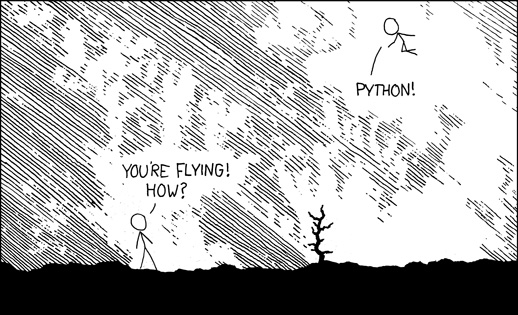
|
1 2 3 4 5 6 |
''' Happy Learning! Tarik Adnan Moon Harvard College, Class of 2015 ''' |
Previous Part: Part 0: Introduction
Next Part: Part 2: Preparing for the Magic
All parts: Play with Python
Posted in Education, English, Python
Also tagged beginners, education, programming, python
Leave a comment
Play with Python: A Beginner’s Guide to Programming- Part 0
Why Programming?
Why learn coding when you can learn so many other things like playing a guitar, watching a movie, or just chatting with your friends on Facebook? I am not asking you to stop doing any of those, but just think for a second how cool it would be if you learned a bit of programming and could make your own games, animation, website, or even a guitar tuner that helps you to tune your guitar! If you do any of these, I can guarantee you that it would be one of the most fun things you have ever done. And that’s why I am writing this tutorial to help you learn programming.
If you look around, you will realize that everything is becoming so computer dependent now. From your cellphone to traffic lights on your way to school, everything is run using computers. Do you know who made computers do these amazing jobs? Those are smart people like you, but they know how to write programs to make computers work for us.
From mathematics, economics, physics to political science and history, people are using quantitative methods and computer programs to analyze data and find new theories based on those. So basically no matter what field you are interested in computer programs can be very useful. Plus if you look at the mainstream technology companies, you will see that they are doing really cool works to make our life easier by creating products like facebook, Instagram, or google search! And if you need inspiration from them about why you need to learn coding watch the video made by superstars!
Maybe you are thinking that when you grow up you will do business or become an artist and live in Paris (or maybe you already are a businessman or an artist). You can probably hire someone to do these. That is true, but you still need to know how computer works to even understand what you need. Plus if you can code you can make your own website or understand what you need to add to your website! If you are a business-person, you will understand better how to run your company better. Moreover, at a basic level learning coding teaches you problem solving skills, which are valuable no matter what you do in life. Watch this video by Scientist to learn how learning programming or science in general can rewire your brain! Watch the video by Neil deGrasse Tyson if you need more convincing.
Who can Learn?
You! If you were patient enough to read up to this point, you can learn programming! The approach to teach problem solving and programming python will be similar to story-telling. I will try to tell real life stories and problems that you will solve with your coding skills. And at the end of the course you will work on a final project that will need all the ideas you will learn throughout the course.
This tutorial will not have any advanced math component, so if you know how to count — I mean add, subtract (and sometime multiply and divide!) numbers, you should be fine. In terms of age group, this is most suitable for 12 – 18 years old people (mostly middle to high school students), but I don’t see why people of other age group will not be able to learn from it.
Finally, as I have mentioned the final project, what is the final project, you may ask! Wait for a surprise— you will make a full blown computer game (with nice graphics, animation, and sound) from zero knowledge of programming! And I will help you to go through this journey to be able to do so. Imagine from less than a month from now, you will be able to create your own game and show it to your friends! How cool is that!
|
1 2 3 4 5 6 |
''' Happy Learning! Tarik Adnan Moon Harvard College, Class of 2015 ''' |
Next Part: Part 1: The Magic Behind Computers
All parts: Play with Python
রুবিকস কিউব (পর্ব ৪) : রুবিকস কিউবের সমাধান
অনেকেই রুবিকস কিউবের সমাধানের উপায় জানতে আগ্রহী। কিন্তু আসলে সমাধানটা এত সহজ না। আমি সবচেয়ে সহজ এলগোরিদমটা এখানে দিলাম। এটার নাম লেয়ার বাই লেয়ার মেথড। (তবে সহজ হওয়ার কারণে এই মেথডে সমাধান করতে বেশ সময় লাগে, তবে সবাই সাধারণত এই এলগরিদম দিয়েই শুরু করে।)
সমাধানের জন্য, প্রথমেই যেকোন একটা কালারের লেয়ারকে আপার লেয়ার ধরে শুরু করতে হবে। (এখানে মনে রাখতে হবে যে, সেন্টার পিসের কালার ঐ লেয়ারের কালার নির্দেশ করে।) আর আরেকটা বিষয় হল যেকোন কালার দিয়ে শুরু করা যায়, কেবল মুভগুলো আমার মুভ নোটেশনের সাথে সঙ্গতিপূর্ণ হতে হবে। আমি এখানে সবুজ রং আপার লেয়ারে আছে বলে ধরে নিচ্ছি করছি। এখানে চিত্রগুলোতে প্রথমে প্রতি স্টেপে সম্ভাব্য যেসব পজিশন সম্ভব সেসব পজিশন এবং তারপর কোনমুভ দিয়ে সেখান থেকে পরবর্তী পজিশনে যাওয়া যায় তা দেখানো হল।
১.(ক) প্রথম লেয়ার (প্রথম ক্রস)
চিত্রের ডানপাশের মত করে ক্রস মেলাতে হবে। অর্থাৎ, মিডল লেয়ারগুলোর সেন্টার পিস আর আপর লেয়ারের মিডলপিসের রং ঠিক করা।এই স্টেপটা আসলে নিজে নিজেই করতে হবে।;) (ভয় পাবার কিছু নেই, কারণ কিছুক্ষণ চিন্তা করলেই বোঝা যাবে যে, কিভাবে একটা পিসকে ক্রসে আনতে হবে) তবে, এই স্টেপটাতে সবচেয়ে সমস্যা করে যে পজিশনটা, সেটার জন্য মুভ নোটশন দেওয়া হল।
F’ U L U’
১.(খ) প্রথম লেয়ার (কর্নার পিস)
রুবিকস কিউব (পর্ব ৩) : রুবিকস কিউবের মুভ নোটেশন
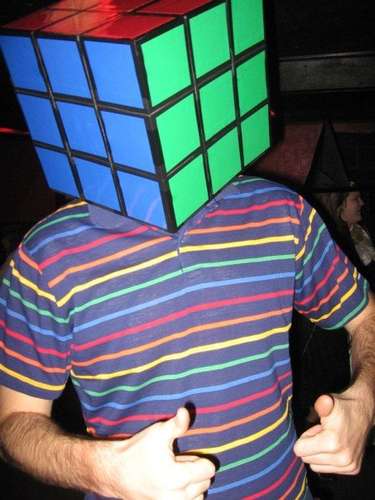 অনেকেই রুবিকস কিউবের সমাধান করার কৌশল জানতে ইচ্ছুক। রুবিকস কিউবের বিশেষ বৈশিষ্ট্যই হল এর বৈচিত্র্য। গাণিতিকভাবে প্রমাণ করা যায় যে,রুবিকস কিউবের ঠিক 43,252,003,274,489,856,000 টি অনন্য বিন্যাস পাওয়া সম্ভব!) তাই, কোন বিশেষ পদ্ধতি বা এলগোরিদম ব্যবহার না করে রেন্ডম মুভ দিয়ে এটা সমাধান করার সম্ভাবনা নেই বললেই চলে।
অনেকেই রুবিকস কিউবের সমাধান করার কৌশল জানতে ইচ্ছুক। রুবিকস কিউবের বিশেষ বৈশিষ্ট্যই হল এর বৈচিত্র্য। গাণিতিকভাবে প্রমাণ করা যায় যে,রুবিকস কিউবের ঠিক 43,252,003,274,489,856,000 টি অনন্য বিন্যাস পাওয়া সম্ভব!) তাই, কোন বিশেষ পদ্ধতি বা এলগোরিদম ব্যবহার না করে রেন্ডম মুভ দিয়ে এটা সমাধান করার সম্ভাবনা নেই বললেই চলে।
কিন্তু, রুবিকস কিউব সমাধান করার জন্য আগে এর মুভ নোটেশন জানতে হবে। কারণ, রুবিকস কিউব সমাধানের বিভিন্ন অবস্থার জন্য যেসব মুভ দেওয়া লাগে তা মুভ নোটেশনের মাধ্যমে সহজে প্রকাশ করা যায়, আর সেভাবে এলগোরিদম ব্যবহার করে সমাধান করা যায়।
(আর… এলগোরিদম বিষয়টা আসলে কিছুইনা, এটাকে সোজা বাংলায় বলা যেতে পারে কার্যপদ্ধতি, অর্থাৎ, যেসব মুভ দিলে কোনে বিশেষ অংশ মেলানো যাবে সেগুলোর সমষ্টিই হল এলগোরিদম)
রুবিকস কিউব (পর্ব ২): রুবিকস কিউব সমাধান: আশ্চর্য সব রেকর্ড!
রুবিকস কিউব যারা হাতে নিয়ে দেখেছেন এবং মেলানোর চেষ্টা করেছেন তারা জানেন যে এটা মেলাতে কতটা বুদ্ধি লাগে এবং কতটা শক্ত এটা মেলানো। কিন্তু তারপরও, প্রোফেশনাল সলভারদের সলভিং-এ সময় এতটাই কম লাগে, যে মনে হয় চোখের পলক না ফেলতেই সমাধান হয়ে যায়।
রুবিকস কিউব দ্রুত সমাধানকে বলা হয় স্পিডকিউবিং। স্পিডকিউবিং এর প্রথম প্রতিযোগিতা হয় ১৯৮১ সালে মিউনিখে। তবে, অফিসিয়াল ওয়ার্ল্ড কিউবিং কম্পিটিশন শুরু হয় ১৯৮২ সালে।
ওয়ার্লড কিউ এসোসিয়েশনের সর্বশেষ তথ্য অনুসারে সবচেয়ে দ্রুততম সমাধানের রেকর্ড অস্ট্রেলিয়ার Feliks Zemdegs এর দখলে। তিনি ২০১১ সালে মেলবর্ন উইন্টার ওপেনে মাত্র ৫.৬৬ সেকেন্ডে সমাধান করেন! (নিচে ভিডিও দেওয়া আছে)
রুবিকস কিউব নিয়ে আগ্রহ না থাকলেও যদি ধাঁধা নিয়ে আগ্রহ থাকে তবে নিচের অসাধারণ ভিডিওগুলো দেখতে থাকুন। ![]()
১. বর্তমান বিশ্বরেকর্ড! (5.66 সেকেন্ডে, Feliks Zemdegs, Melbourne Winter Open 2011)
রুবিকস কিউব (পর্ব ১) : এটা আসলে কী?
আমাদের দেশে এককালে ধাঁধা বা পাজল নিয়ে মানুষের আগ্রহ থাকলেও, এখন আমাদের দেশের মানুষ বুদ্ধিভিত্তিক বিনোদন থেকে অনেকটাই দূরে সরে গেছে।
পৃথিবীর সবচেয়ে জনপ্রিয় পাজলগুলোর একটা হল রুবিকস কিউব। রুবিকস কিউব নিয়ে ধারাবাহিক কয়েকটা পোস্ট দেব। প্রথম পর্বে থাকছে রুবিকস কিউবের সংক্ষিপ্ত পরিচিতি। Continue reading





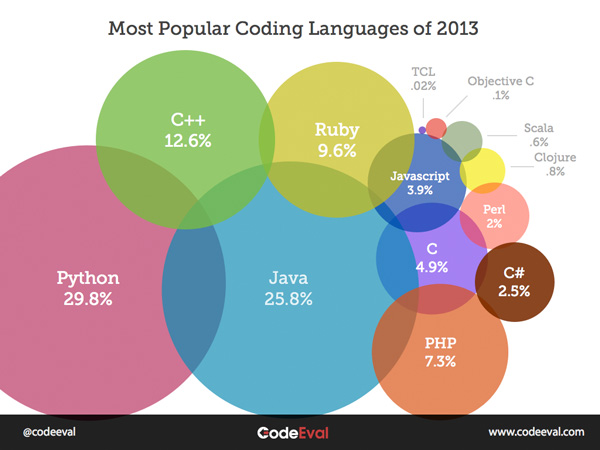


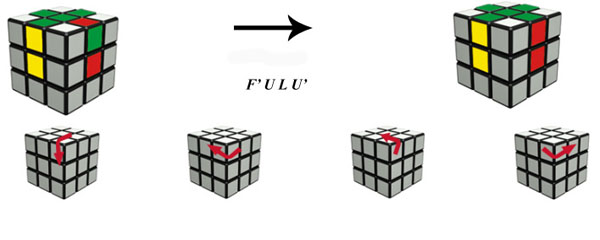
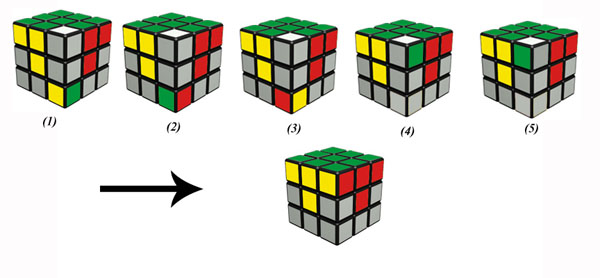




 Welcome to my blog on education, mathematics, travel, photography, and random stuff. You can find my posts in Bangla and English separately:
Welcome to my blog on education, mathematics, travel, photography, and random stuff. You can find my posts in Bangla and English separately: